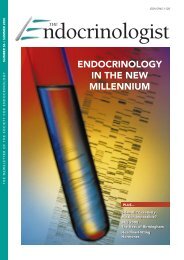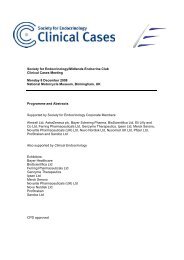Standards for undergraduate medical education - Society for ...
Standards for undergraduate medical education - Society for ...
Standards for undergraduate medical education - Society for ...
Create successful ePaper yourself
Turn your PDF publications into a flip-book with our unique Google optimized e-Paper software.
FEATURES<br />
How much do you charge <strong>for</strong> an insulin<br />
stress test What endocrinologists should<br />
know about clinical coding<br />
Most endocrine investigations are conducted in a specialised outpatient environment requiring trained staff and access to<br />
experienced clinicians. Different endocrine departments will have their own arrangements <strong>for</strong> per<strong>for</strong>ming these tests, based on<br />
the resources available. Read on to learn how hospitals are funded <strong>for</strong> these investigations, and to ensure your hospital<br />
receives the amount to which it is entitled.<br />
From a coding point of view, a patient attending an<br />
investigation unit can be labelled either as an<br />
outpatient visit or as a day case admission. There is a<br />
significant difference in the tariff which is applied to<br />
these two types of attendance, the day case admission<br />
attracting four times more funding than the outpatient<br />
fee.<br />
Dynamic endocrine tests are skilled, specialised, timeconsuming<br />
and carry a small risk of complications which<br />
need observation and management. On this basis, it<br />
seems appropriate <strong>for</strong> a dynamic endocrine test, such an<br />
insulin stress test, to be charged as a day case admission,<br />
analogous to the way an endoscopy unit would charge.<br />
Once it has been established that the endocrine test is<br />
being conducted as a day case admission, we can consider<br />
how the funding <strong>for</strong> the test will be constructed. The<br />
payment is determined by the HRG (healthcare resource<br />
group), which is a nationally fixed tariff, derived from the<br />
elements of the day case admission. The clinical coding<br />
service will input a patient’s diagnosis, their co-morbid<br />
conditions and the nature of the procedure undertaken.<br />
The coding algorithm will generate an HRG.<br />
Theoretically, the HRG is derived from a combination of<br />
the diagnosis and procedure, as well as the admission<br />
method. However, in practice, with regard to day case<br />
endocrine tests, the HRG is exclusively derived from the<br />
diagnostic label given to the patient. For example, a<br />
patient with a pituitary mass who attends <strong>for</strong> an insulin<br />
stress test will generate the same HRG and same costing as<br />
one who attends <strong>for</strong> a water deprivation test, or any other<br />
test. If a patient has two dynamic tests done on the same<br />
day that makes no difference to the overall charge.<br />
We have established that a patient having a dynamic<br />
endocrine test can legitimately be admitted as a day case<br />
and that the cost attached to that admission will be<br />
determined by the patient’s coded diagnosis. Patients who<br />
are having endocrine investigations may have more than<br />
one diagnostic label. For example, a patient with cortisol<br />
excess due to an ACTH-secreting pituitary tumour could<br />
legitimately be coded either as Cushing’s disease or as<br />
pituitary tumour, or as both.<br />
Endocrinologists would probably instinctively emphasise<br />
the hormone abnormalities, but this may be unwise. It is<br />
important to be aware that, almost always, a hormone<br />
diagnosis attracts a lower charge than a tumour diagnosis.<br />
So, to continue our example, a patient who is stated to<br />
have a pituitary tumour will be coded as an endocrine<br />
gland tumour, which will generate a HRG tariff code<br />
within the brain tumour category, whereas a patient who<br />
is only recorded as having Cushing’s will attract an HRG<br />
tariff code within the anterior pituitary disorder category.<br />
Both labels are correct but the HRG <strong>for</strong> anterior pituitary<br />
disorder attracts about 15% lower costs than the brain<br />
tumour HRG. From a coding point of view it is important<br />
to ensure that any tumour the patient has is mentioned as<br />
part of the diagnosis.<br />
USE OUTPATIENT<br />
CODING TARIFF<br />
LOW<br />
CHARGE<br />
DYNAMIC<br />
ENDOCRINE<br />
TEST<br />
USE DAY-CASE<br />
CODING TARIFF<br />
HIGHER<br />
CHARGE<br />
18 T H E E N D O C R I N O L O G I S T • I S S U E 1 0 3 • S P R I N G 2 0 1 2


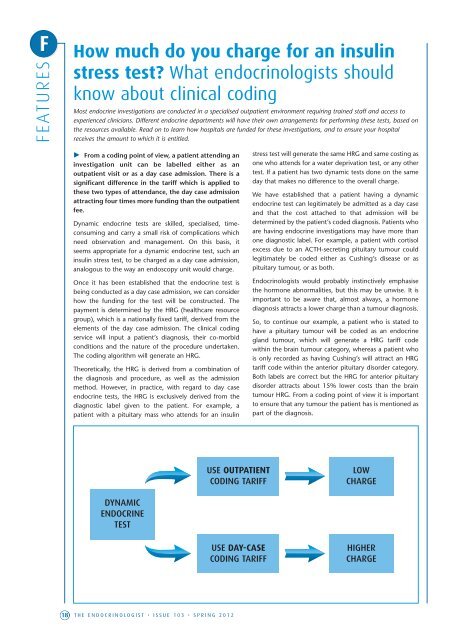

![The Endocrinologist | Issue 99 [PDF] - Society for Endocrinology](https://img.yumpu.com/48213777/1/184x260/the-endocrinologist-issue-99-pdf-society-for-endocrinology.jpg?quality=85)


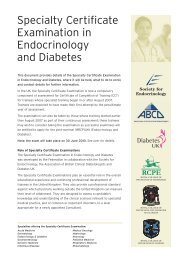

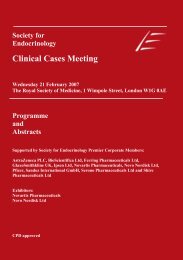

![The Endocrinologist | Issue 97 [PDF] - Society for Endocrinology](https://img.yumpu.com/40840065/1/184x260/the-endocrinologist-issue-97-pdf-society-for-endocrinology.jpg?quality=85)

